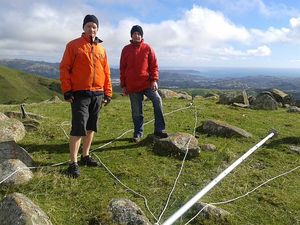 A joint project by NIWA and OPUS Research is measuring how wind speeds up over rough terrain, with the aim of improving the building code. Hill shape has a huge effect on wind speed and can increase the wind’s speed by three compared to nearby flat terrain.
A joint project by NIWA and OPUS Research is measuring how wind speeds up over rough terrain, with the aim of improving the building code. Hill shape has a huge effect on wind speed and can increase the wind’s speed by three compared to nearby flat terrain.
By comparing results from the field, wind tunnel and computer modelling with existing loading calculations, the research team hope to identify whether the current wind loadings in the building code are adequate or whether they should be revised.
Wind is one of a number of environmental factors - along with earthquakes, snow and exposure – that is taken into account in building standards for houses in New Zealand. There are currently six wind zones recognised in New Zealand, and in specified wind design areas - where wind speed can reach more than 55 metres/second - a structural engineer needs to calculate wind loading, using the Australasian wind loadings standard AS/NZS1170.2, 2010.
In 2011, NIWA carried out preliminary field measurements of wind speeds during a storm event using anemometers on top of 5 metre high masts placed in a transect across the Belmont Hills, between Porirua and the Hutt Valley, north of Wellington. A range of computer models of the same storm event were run, and a terrain model of the topography was built and tested in a wind tunnel at OPUS Research. These preliminary results showed that while there was good agreement between the field measurements and the modelling and wind tunnel results, there was up to a 40% variation between estimates based on the current loading standards and the field measurements, which suggests the current loadings standard is not adequate for estimating wind speed in terrain as complex as that of the Belmont Hill area.
NIWA is currently carrying out more field measurements using 10 metre high masts and is modelling a greater range of wind speeds and directions. Our Changing World producer Alison Ballance joined NIWA Principal Scientist Mike Revell and NIWA Principal Technician Tony Bromley in the Belmont Hills to hear about the project and some of the difficulties it faces, including strong winds bending the masts and sheep chewing the masts’ guy ropes.
“We had a big southerly storm last year. We think the winds were up over 200 kilometres per hour and it basically just made our mast into a staple” said Mike Revell. “If I’ve learnt anything in this experiment … it’s how difficult it is, actually, to collect good data in a remote and windy area.”
Our Changing World has previously featured a story about the wind tunnel at OPUS Research, in a project testing the performance of umbrellas in strong winds.

